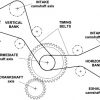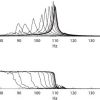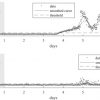Abstract
In the last years, Blind Deconvolution methods demonstrated their effectiveness for the diagnostics of rotating machines through the extraction of impulsive signatures directly from noisy observations. Recently, in this scenario the explicit combination between Blind Deconvolution and cyclostationary theory strongly improved the fault detection ability of this diagnostic tool. This work presents a novel criterion based on the Fourier–Bessel series expansion instead of the common Fourier transform. This idea comes from the comparison between the mathematical nature of the Fourier–Bessel and the Fourier series, based on modulated and constant amplitude sinusoidal functions, respectively. The two criteria are compared through the analysis of both simulated and real vibration signals of faulty bearings. The results highlight the ability of the proposed criterion to detect the fault-related source with a lower number of characteristic cyclic frequency harmonics, strongly reducing the computational time required by the algorithm.
Links
BibTeX (Download)
@article{Soave2022,
title = {Blind deconvolution criterion based on Fourier–Bessel series expansion for rolling element bearing diagnostics},
author = {Soave Elia; D'Elia Gianluca; Cocconcelli Marco; Battarra Mattia},
doi = {10.1016/j.ymssp.2021.108588},
issn = {08883270},
year = {2022},
date = {2022-04-15},
journal = {Mechanical Systems and Signal Processing},
volume = {169},
number = {108588},
abstract = {In the last years, Blind Deconvolution methods demonstrated their effectiveness for the diagnostics of rotating machines through the extraction of impulsive signatures directly from noisy observations. Recently, in this scenario the explicit combination between Blind Deconvolution and cyclostationary theory strongly improved the fault detection ability of this diagnostic tool. This work presents a novel criterion based on the Fourier–Bessel series expansion instead of the common Fourier transform. This idea comes from the comparison between the mathematical nature of the Fourier–Bessel and the Fourier series, based on modulated and constant amplitude sinusoidal functions, respectively. The two criteria are compared through the analysis of both simulated and real vibration signals of faulty bearings. The results highlight the ability of the proposed criterion to detect the fault-related source with a lower number of characteristic cyclic frequency harmonics, strongly reducing the computational time required by the algorithm. },
keywords = {Battarra M., Cocconcelli M., D'Elia G., Soave E.},
pubstate = {published},
tppubtype = {article}
}








